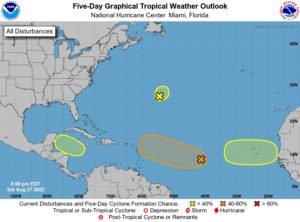Previous posts in this series:
Volcanic ash and climate change

You hear it all the time. “Look at this cold snap. No way does global warming exist,” or “See how hot the summer it? That proves global warming exists,” or “Tornadoes, hurricanes, and blizzards show that climate change is really happening.”
If only it were that easy. We need to learn to differentiate weather from science. Weather is what’s happening today, what’s predicted to happen for the next 15 days, and maybe what the different almanacs suggest will happen over the next couple of seasons. Climate is the norm for the area, based on years and years of data.
How many years? Well, if I’m remembering what I learned in “Earth Sciences”, 2nd semester freshman year (1971), with professor Dr Edward Higbee, climate is figured on a 40-year basis. Average the conditions over the last 40 years, and there’s your climate. Once you have a new year of data, drop the year 41 years ago, add the new year, recalculate the average. A 40-year moving average.
I wonder if I’m remembering that correctly. Forty years seems a very short time to say this is our climate. Seems like a hundred, or several hundred, or even a thousand years would be better to define climate.
The problem is available data. A thousand years ago, no one was taking daily or hourly temperatures in 6,000 stations spaced scientifically around the world. No one was measuring upper atmospheric temperatures. That’s not to say we have no evidence of what the climate was 1000 years ago, but we don’t have much data.
Which leads me to wonder if 40 years was chosen more based on convenience than science. Sometime, maybe 80 or 100 years ago, someone decided to base climate on 40 years of data because that’s how much comprehensive data they had accumulated to that point. So they established the 40-year moving average as the basis for climate.
There may be some validity to the 40 years. I just don’t know. That seems short enough that the data can be skewed by certain events. For example, I said in a prior post that I thought the “mini-ice age” of the 1960s-70s was caused by air pollution—lots of particulate matter in the global atmosphere. It took a decade before the positive impacts of the Clean Air Act of 1969 began to have an impact. Maybe by 1990-ish, the atmosphere was cleaner, and temperatures worldwide were probably back to their norm. But, the data from 1950-1975 (call them the years of maximum pollution) still dominated the 40-year moving average, a.k.a. the climate. In fact, it wouldn’t be until 2015 that the impact of the mini-ice age was fully gone from the climate average and we had an accurate picture of the climate and if it was changing.
Now, if you say that the worst of the polluting years were 1950-1975, and I’d accept arguments that maybe it was a little different than that, then you also have years on either side of those that were also polluting years, just maybe not quite so much. So the 1940s and 1975-1985, say, were also polluting years, but perhaps less so. I’d make the argument that beginning in 1986, global average temperatures would start to go up as atmospheric pollution went down, and be noticeable in the change in the moving average over the previous five years, because you dropped off the polluting years of 1940-1945 and added the normal, non-polluting years (or call them the much less polluting years) of 1980-1985. And it appears you have global warming. Continue another 10 years and you drop more polluting years, add more normal years, and boom, you have higher temperatures.
The change was indeed manmade, but in this case man’s polluting his world in the 1940s, 50s, 60s, and 70s, and reducing his pollution in the 1980s, 90s, 00s, etc.
Does this make sense? It does to me. I need to study some data to see if my suppositions are correct. No, suppositions is not the right word. It’s more musing, or all-other-causes elimination. Those who claim climate change is totally manmade need to consider whether coming out of the polluting years might have skewed the data for 20 years, because for 20 years we were killing out atmosphere with pollution.
In a later post in this series, I’m going to talk about longer-term climate and whether that’s changing as a result of mankind’s activities.
What’s next? Stay tuned.